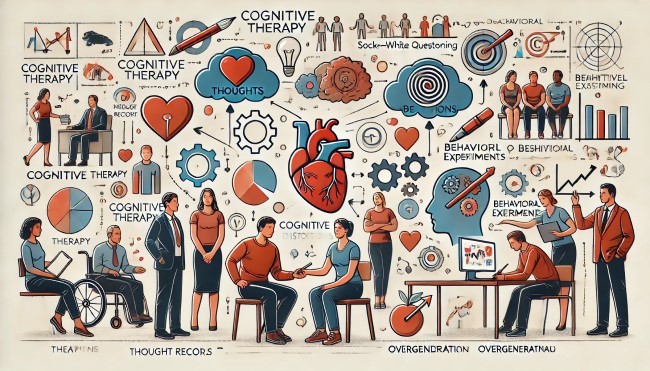Which Principle Underlies Cognitive Therapy? Transform Your Thoughts, Transform Your Life
Unveiling the Core of Cognitive Therapy: Empowering Change Through Thought Transformation

Cognitive therapy, a powerful tool in the mental health arsenal, hinges on the transformative principle that our thoughts, emotions, and behaviours are deeply interconnected. This understanding lays the groundwork for effective therapeutic intervention to reshape negative thought patterns and improve overall mental well-being.
Introduction: The Power of Cognitive Therapy
Cognitive therapy has revolutionized the treatment of various mental health conditions, from depression and anxiety to phobias and eating disorders. By addressing the core principle of interconnected thoughts, emotions, and behaviours, cognitive therapy empowers individuals to take control of their mental health, fostering resilience and promoting lasting positive change.
Understanding Cognitive Therapy
Cognitive therapy, developed by Aaron Beck in the 1960s, is a type of psychotherapy that focuses on identifying and altering negative thought patterns that contribute to emotional distress and maladaptive behaviours. The core principle of cognitive therapy is that our thoughts, emotions, and behaviours are interconnected, and by changing our thoughts, we can alter our feelings and behaviours.
The Interconnectedness of Thoughts, Emotions, and Behaviors
At the heart of cognitive therapy lies the understanding that thoughts, emotions, and behaviours are deeply intertwined. Negative thought patterns can lead to emotional distress and unhealthy behaviours. Conversely, by reshaping these thoughts, individuals can experience significant improvements in their emotional state and actions.
Cognitive Distortions: The Culprits Behind Negative Thinking
Cognitive distortions are irrational thought patterns that contribute to negative emotions and behaviours. Common cognitive distortions include:
- Black-and-White Thinking: Viewing situations in extreme terms without recognizing the middle ground.
- Overgeneralization: Making broad assumptions based on a single event.
- Mental Filtering: Focusing solely on negative aspects while ignoring positive ones.
- Catastrophizing: Expecting the worst possible outcome in any situation.
Identifying and Challenging Negative Thoughts
The first step in cognitive therapy is to identify negative thought patterns. This involves becoming aware of one’s inner dialogue and recognizing thoughts that lead to distressing emotions. Therapists use various techniques, such as thought records and Socratic questioning, to help individuals identify these thoughts.
Thought Records
Thought records are tools used to track negative thoughts, emotions, and situations. By keeping a record, individuals can see patterns in their thinking and understand the triggers for their distress.
Socratic Questioning
Socratic questioning is a technique for challenging irrational beliefs and assumptions. Through guided questioning, therapists help clients explore the validity and logic of their thoughts, promoting critical thinking and a more balanced perspective.
Cognitive Restructuring: Reframing Negative Thoughts
Once negative thoughts are identified, the next step is cognitive restructuring, which involves challenging and altering these thoughts. This process helps individuals develop more balanced and realistic perspectives, reducing emotional distress and promoting healthier behaviours.
Evaluating the Evidence
Individuals are taught to evaluate the evidence supporting their negative thoughts critically. They are encouraged to ask questions like, “Is there concrete evidence to support this thought?” or “What are the alternative interpretations?” This process helps individuals see the flaws in their negative thinking and develop more rational alternatives.
Generating Alternative Thoughts
Clients work on generating more balanced and realistic alternative thoughts. This step involves reframing negative thoughts into more constructive ones, fostering a positive outlook.
Behavioural Experiments: Testing New Beliefs
Behavioural experiments are powerful tools in cognitive therapy. They allow individuals to test the validity of their beliefs and assumptions through real-world experiences. This technique involves creating controlled situations to challenge and modify thought patterns.
Hypothesis Formulation
Therapists help clients formulate specific hypotheses about their thoughts and beliefs. For example, if a person believes they are “always incompetent,” a hypothesis could be that they can complete a task.
Experiment Design
Together, the therapist and client design experiments to test the hypothesis. This might involve setting up situations where the client can gather evidence that supports or contradicts their opposing beliefs.
Data Collection and Discussion
During and after the experiments, clients collect data to evaluate the accuracy of their beliefs. This data-driven approach helps individuals see the real-world consequences of their thoughts, fostering a shift towards more adaptive thinking.
Practical Coping Strategies
Cognitive therapy equips individuals with practical coping strategies to manage their symptoms. These strategies include problem-solving skills, stress management techniques, and relaxation exercises.
Problem-Solving Skills
Problem-solving skills help individuals tackle real-life challenges rationally and effectively. This involves identifying problems, generating potential solutions, evaluating the options, and implementing the chosen solution.
Stress Management Techniques
Stress management techniques like deep breathing exercises and progressive muscle relaxation help individuals reduce physical tension and manage anxiety. These techniques promote relaxation and enhance emotional well-being.
Relaxation Exercises
Relaxation exercises, including mindfulness meditation and deep breathing, help individuals manage stress and anxiety. These techniques promote a sense of calm and well-being, allowing individuals to better control their thoughts and emotions.
Preventing Relapse
A crucial component of cognitive therapy is its emphasis on relapse prevention. By teaching individuals to manage their thoughts, they are better equipped to tackle future challenges and reduce the likelihood of relapse.
Recognizing Early Warning Signs
Individuals learn to recognize early warning signs of distress, allowing them to take proactive steps to address their symptoms before they escalate.
Employing Coping Strategies
By employing coping strategies learned in therapy, individuals can manage their symptoms and maintain their mental well-being.
Applications of Cognitive Therapy
Cognitive therapy has been effectively applied to a wide range of mental health conditions, including:
- Depression: Cognitive therapy helps individuals recognize and challenge negative thought patterns that contribute to feelings of hopelessness and low self-esteem.
- Anxiety Disorders: Cognitive therapy addresses irrational thoughts and beliefs that contribute to anxiety, helping individuals develop healthier perspectives and coping strategies.
- Eating Disorders: Cognitive therapy helps individuals address dysfunctional beliefs about body image and self-worth, promoting healthier eating habits and improved self-esteem.
- Substance Use Disorders: Cognitive treatment provides individuals with the tools to recognize and challenge the thoughts and behaviours that contribute to substance use, promoting long-term recovery.
Conclusion: Transforming Lives Through Cognitive Therapy
Cognitive therapy’s core principle of interconnected thoughts, emotions, and behaviours offers a robust framework for mental health treatment. By identifying and challenging negative thought patterns, individuals can experience significant improvements in their emotional well-being and overall quality of life. Through practical coping strategies and a focus on relapse prevention, cognitive therapy empowers individuals to take control of their mental health and transform their lives.



